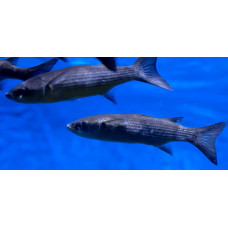Mugilidae is a family of ray-finned fishes of the order Mugiliformes. The head is broad. The mouth is small. The teeth are small. Fish with a closed swim bladder and without a lateral line. Inhabitants of warm and temperate waters of the Pacific, Indian and Atlantic Oceans. More than 14 genera, about 100 species. Marine, brackish-water, freshwater. Pelagic, gregarious euryhaline fish, feeding in coastal waters. Feed on detritus, periphyton, benthos. A gregarious marine fish inhabiting the Black, Azov, and Japan Seas. Spawns from May to September in the sea, far from the coast. It enters freshened waters of estuaries, lagoons, where it feeds on bottom fouling, detritus, swallowing together with them worms, mollusks, crustaceans, insect larvae. Mugilidae are valuable commercial fish, objects of cultivation in estuaries, lagoons and ponds. Chelon saliens and Chelon auratus are acclimatized in the Caspian Sea.
The biology of all mullets is very similar. They breed in the sea a short distance from the shore, with eggs, larvae and fry developing in the water column or at the very surface and can be carried by currents over long distances. Adult mullets stay permanently near the coast and are very common in bays, lagoons, estuaries and lower reaches of rivers. Their main food is detritus (bottom silt enriched with organic matter) and periphyton (plant and animal fouling of the underwater substrate); to a much lesser extent - benthos. Feeding mullets move above the ground at an angle of about 45° to the bottom and scrape off the top layer of silt, using the flat surface of the shovel-shaped lower jaw. The collected detritus is filtered on the gill stamens, then the water is squeezed from the food clump with the help of pharyngeal teeth, and the food is pushed through the esophagus into the muscular stomach, where it is partially grinded. Intestine mullet, in which absorption occurs, due to the peculiarity of their small nutritious food reaches, as in other herbivorous fish, very long. Its length in the straightened state can be 4, 5-6, 5 times the length of the entire body of the fish. In young pelagic mullet feeding on zooplankton, the digestive tract is much shorter than in adult fish.
All mullets are good swimmers. They are very agile and have the ability to jump out of the water when startled. Some species make quite large migratory movements, but most are sedentary fish.
Mugilidae
Tags: mugilidae


